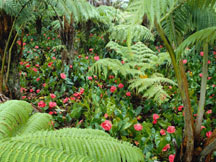Biology Semester II |
|
| Sections: |
|
|
Biology: Plant Structure: Introduction The Plant Kingdom All plants are autotrophs that make their own food by means of photosynthesis. This process takes place inside cells in specialized organelles called chloroplasts. These organelles contain chlorophylls a and b. In plant cells, a cellulose cell wall surrounds a cell membrane, and excess sugar is stored as starch. Plants exhibit an alternation of haploid generations and diploid generations that animals do not exhibit. The fossil record of the plants indicates that this kingdom is the most recently evolved. The oldest fossil plants have been found in rocks more than 400 million years old.
 Members of the plant kingdom are grouped into two broad categories: the bryophytes and the tracheophytes. The tracheophytes are also known as the vascular plants. This group contains the most specialized and highly evolved plants. Members include common plants such as palms, lilies, sunflowers, ferns, and pines. The bryophytes (the nonvascular plants) lack specialized tissues for conducting water and nutrients. These plants include the smaller, and less conspicuous, liverworts and mosses. The vascular plants are subdivided into smaller groups, which include the gymnosperms (the ferns and fern allies) and the angiosperms (the flowering plants). For our discussion of plant structure, we will focus on the last group, the flowering plants. Members of the plant kingdom are grouped into two broad categories: the bryophytes and the tracheophytes. The tracheophytes are also known as the vascular plants. This group contains the most specialized and highly evolved plants. Members include common plants such as palms, lilies, sunflowers, ferns, and pines. The bryophytes (the nonvascular plants) lack specialized tissues for conducting water and nutrients. These plants include the smaller, and less conspicuous, liverworts and mosses. The vascular plants are subdivided into smaller groups, which include the gymnosperms (the ferns and fern allies) and the angiosperms (the flowering plants). For our discussion of plant structure, we will focus on the last group, the flowering plants.
Graded Activities:
Writing is a good way to learn a language. Using the vocabulary journal, write down the definition and examples as you see them in your lessons. Include an example of your own and an image that you can use to help remind you what the word means. Click here to download the vocabulary journal. |
|
© 2009 Aventa Learning. All rights reserved. |